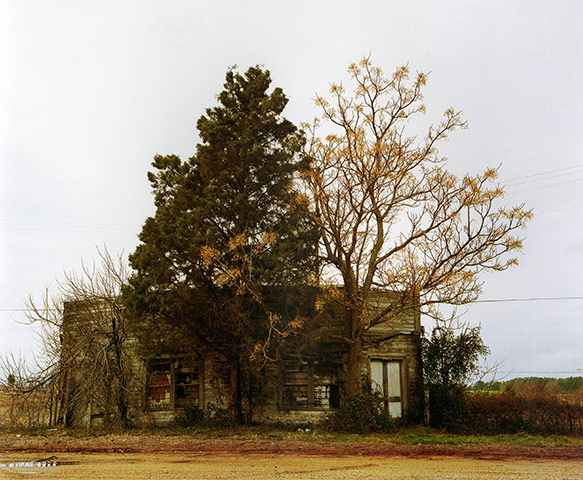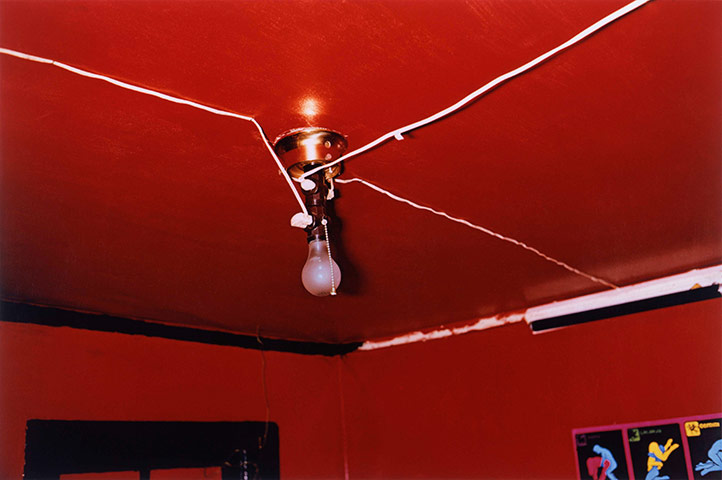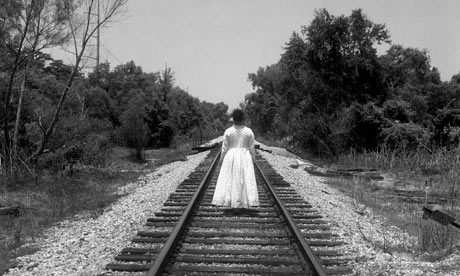This show celebrates the American South's beauty and mystery. It has been forever mythologised in literature, art, photography and music. Think "Huckleberry Finn", Tennesee Williams poetry and The Father of Blues. Over the years, this ideal has entered the popular worldwide imagination. Who hasn't considered an American Roadtrip at some point in their lives? I know I have. I'm not ashamed to say "Elizabeth Town" is a firm favourite film of mine. Despite my own lack of travelling, I have always wanted to disappear to America and not come back until I've seen it all....so needless to say, I was VERY excited to see this show, my own dreams materialised!
Luckily, this exhibit escaped the "No Framing" rule of the festival (thank god for that) and the space looked really fantastic.
As soon as you enter the exhibit, Susan Lipper's project "Grapevine series" lurks in a darkened corner, and instantly draws you in...

Susan Lipper - Untitled, from the Grapevine series, 1988-1992
Susan Lipper is a New Yorker who spends several months every year in Grapevine Hollow, a remote rural community in the Appalachian mountains.
Through these images, you instantly become a visitor to a eerie sideshow circus. Despite many of her images being staged, Lipper's subjects are very much real. She plays with stereotypes of the American South, "Rednecks, White Trash and The Ominous Blackwoods". Think "Gummo", "The Texas Chainsaw Massacre" and Edgar Allan Poe all rolled into one terrifying neighbourhood. It's uncomfortable, but in that wonderful way that you can't tear your eyes away even if you wanted too!
Her portraits are certainly a long way from Walker Evans series just around the corner...but isn't that the point? The American South seems not to be different states as such, more overlapping narratives, all contradictory but all able to tug at our imaginations.
William Christenberry's work is exhibited in several ways, he has one wall of around 30 miniature prints from his "Dream Buildings" series, whilst on the opposite wall are larger prints, all beautifully printed. My personal favourite was "Rabbit Hutch", an image which I haven't actually seen before! It's quite shocking really, the animals fur sticks through the haphazard wire of the cage and grazes the barbed wire below. This 'DIY' aspect is something I definitely link to The South. DIY that's gone slightly wrong always tugs at my heartstrings, as it's quite close to home!

William Christenberry - Rabbit Pen, near Moundville, Alabama, 1998
William Christenberry began as a painter, and I believe that does shine through his photographic work. I find this series to be memorial, funerary portraits. The abandoned decaying buildings with the ever growing "Kudzu" plant eating everything in sight. His photographs of Southern buildings give them souls, they have roots that bind themselves into this "Southern-ness". He has taken Alabama as his muse, and is determined to examine it as deeply as he can, from the soil upwards.

William Christenberry - Palmist Building (Winter), Havana Junction, Alabama 1981
Now, we can't talk about Christenberry without talking about Walker Evans, however, (and i'm sorry to say this) I felt that Evans fell through the cracks at this show, his position within the space wasn't the best, and to be honest, it was just unexciting. I understand the images speak of the great depression of 1930's, and are therefore synonymous with the poverty and slavery that fills the history of America... but they still could have been in a more exciting, refined edit. However, one thing I will say for the images on show is they do handle the subject matter with a great dignity, Evans doesn't rob people of their image, he is respectful and duteous.

Walker Evans - "Alice Mac Burroughs" 1936
William Eggleston had some absolutely beautiful work on show, particularly his dye-transfer prints on the first wall. Eggleston also looks with an insiders eye, but his version of "The South" is definitely darker, the 'everyday-ness' of the scenes just adds to the mystery. Eudora Welty, as a southerner herself, understands this gaze:
"in dreaming long view and arresting close-up, through hours of dark and light, he sets forth what makes up our ordinary world. What is there, however strange, can be accepted without question; familiarity will be what overwhelms us."

William Eggleston - Red Ceiling, Greenwood, Mississippi, 1969-1971
After seeing his collaboration commission at the Brighton Bienniel, It was good to see some of Alec Soth's own work again! They showed a selection of his images from "Sleeping by the Mississippi" - my favourite project of his. These are just the quintessential "American Roadtrip" images. I don't think anyone has accomplished as much as Soth has in this theme, his deep relationship with both his subjects and the landscape are evident. He clearly does have a 'type' when it comes to portraits though, he certainly finds the perfect sitters in the heartland!
Soth's work has to be seen as a project. Individual images just don't portray the depth of what he does, the effort he takes. This is his journey, and the meaning gathers with every images, turning them into a poem or a great novel. I really would love to own this book! My favourite image in the exhibition was "Johnny Cash's boyhood Home", the resonance of what that tiny house means, and what it once contained, is magical.

Alec Soth - Johnny Cash's boyhood home, Dyess, Arkansas 2002
Soth portrays an American which despite experiencing important social and political change, has stayed virtually the same. The portraits seem lost in time, the landscapes are merely echoes. They are very slow images. The Mississippi river and the old plantations remain powerful.

Alec Soth - Venice, Louisiana 2002
The images by Carrie May Weems could be said to be the most political of the show, as she confronts the history of racism in American history. She physically places herself in places of resonance, dressed in a "Traditional" 1900 style gown, contrasting the barbaric truth of slavery with the refined nature of the rich families involved. Weem's is a life long work dedicated to exploring the African-American experience, however i did not find this series to be her best. It wasn't as engaging as I hoped, and actually, I think i would have preferred a single, large print, rather than a series of smaller ones. I was disappointed, as I am a fan of her projects, I just didn't find this series one of of her most visually compelling.

Carrie Mae Weems - Standing on the Tracks
You leave the exhibition satisfied. Our ideals of "The South" have been confirmed. Whatever it is that sparks our fascination is fulfilled by Soth and Christenberry's images giving us the romantic, poetic images we yearn for (probably from watching too much "Little House On The Prarie" and "Gone With The Wind") but Susan Lipper brings the morbid curiosity and stereotypes out of us in the end. It is pleasant to think that there are places in the world that can still be traditional. It's difficult to believe these places can survive somewhere as dominant and media-concious as America...
I can't wait to see it for myself. One day!
Thanks for reading!





No comments :
Post a Comment